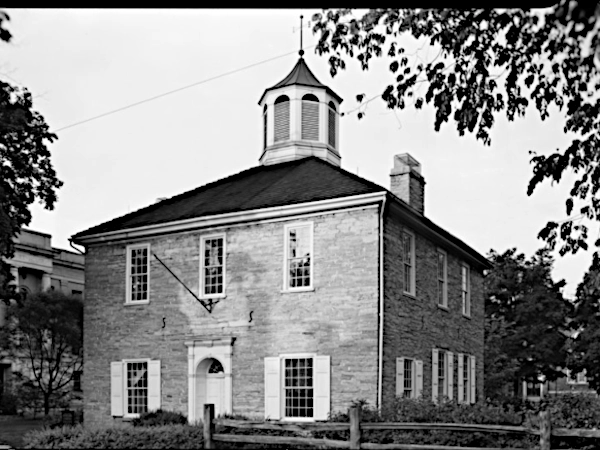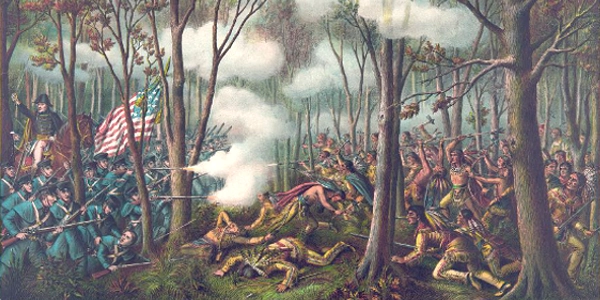Sponsor this page. Your banner or text ad can fill the space above.
Click here to Sponsor the page and how to reserve your ad.
- Timeline
1816 - Detail
December 11, 1816 - The territory of Indiana is admitted into the United States of America as the 19th state.

Indiana had only been a territory for sixteen years before it applied and was granted statehood. The territory had been established by congressional act and signed into existence on May 7, 1800, to be a territory on July 4, 1800. Over the ensuing sixteen years, it had undergone some significant changes, as well as significant events.
The territorial capital was initially the French fort at Vincennes on the Wabash River. First Governor William Henry Harrison made many treaties with the tribes of the territory to cede lands for white settlement, and a bicameral legislature was formed to handle the other matters of state. They formed an education system and transportation network as an appeal to Congress for statehood.
From nearly the beginning of the territory, Indiana had a terrible history on the subject of slavery. Where the Northwest Territory, of which it was carved, banned slavery in that territory, Indiana, in 1802, petitioned Congress to have the ban on slavery lifted for ten years, in order to attract slave holding residents. However, they intended to make the attracted slaves remain slaves even after the ban was reinstated. Congress said no.
But William Henry Harrison, Governor of the Territory, and the Territorial Legislature did not stop there. They passed indentured servitude laws in 1803 which essentially allowed slavery by another name. And when they got a representative in Congress, they got that ten year suspension previously looking for, evading the Ordinance of 1787, suspending its Article Six ban for that period. That law was not universally accepted by Indiana residents; the Quakers and St. Clair County, who wanted independence, refused to allow the measure to pass. Once Indiana was subdivided into the Michigan Territory in 1805 and Illinois Territory in 1809, Harrison began to lose power. By 1810, the anti-slavery elected legislature banned slavery and overturned the indentured act. In 1810, the territorial census of population was 24,520.
However, Tecumseh's War caused a delay in any action toward statehood, fought many times within Indiana Territory, with the most famous battle, the Battle of Tippecanoe, occurring on November 7, 1811. With the War of 1812 coming directly on the heals of the Indian war, statehood was pushed back again. After Harrison stepped down as Governor, the opposition party led by Congressman Jonathan Jennings began to control the affairs of the territory, and on December 11, 1815, brought the topic of statehood back to the forefront with the Territorial Legislature passing, only seven to five, to send a Memorial to Congress, stating they were qualified for statehood. One item to hurdle, stating they had sixty thousand white settlers. That may or may not have been accurate, at least unknown until the 1920 census likely proved it true.
Indiana Becomes at State
Congress would pass an Enabling Act, and a state constitutional convention was held at Corydon on June 10, 1816; Corydon had been the territorial capital for three years as a safer option located in the south of the territory away from the native attacks. On June 29, 1816, the state constitution was adopted. It included the first publicly funded education system and allotted one county to house a university. Those goals took decades to achieve, but were thought of and aspired to within the first constitution.
General elections were held to fill state offices. Jonathan Jennings was elected first Governor, and on December 11, 1816, President James Madison signed the Congressional act making Indiana the 19th state. Corydon would remain its capital from 1816 to 1825 when it was moved to Indianapolis. The Corydon state capitol building is now a State Historic Site.
Once statehood came and the question of slavery in Indiana settled, migration to the state from Europe began, with German, Irish, and English immigrants being the most numerous. Resettlement from other eastern states; New York, the states of New England, and Pennsylvania, also helped Indiana start to prosper. By 1820, the population of Indiana had risen to 147,178.

Image above: Photo of the Indiana capitol building while at Corydon, 1940, Lester Jones. Courtesy Historic American Buildings Survey, Library of Congress through Wikipedia Commons. Image below: Lithograph of the Battle of Tippecanoe, 1889, Kurz and Allison. Courtesy Library of Congress. Source Info: Library of Congress; Indiana Statehood, the Indiana Historian; Wikipedia Commons.





